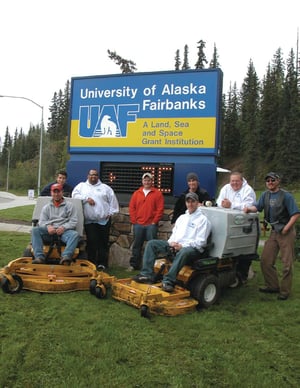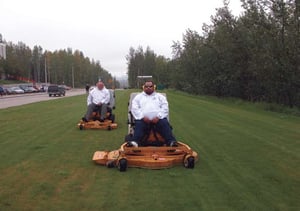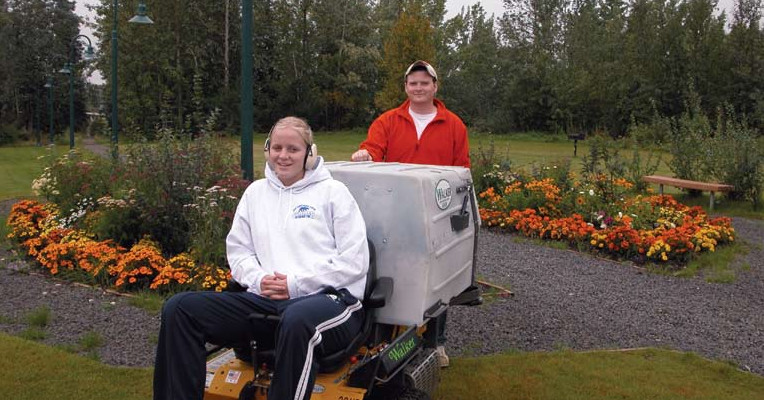The Alaskan growing season may be abbreviated, but is also very intense. Consider what happens when the sun is shining 22 out of 24 hours in mid-summer. “In August, our two Walkers mow eight hours a day five days a week, and sometimes six,” relates Darrin Edson. “Even then, we can hardly keep up with the new growth.”
 Edson (friends call him Bear for short) is grounds supervisor for the University of Alaska Fairbanks. The 2,200-acre campus comes under his care. In addition to mowing 200 acres of turf weekly, Edson and his staff are responsible for just about everything that happens under the sun — from planting 50,000 annuals each spring and summer and edging three miles of sidewalk to stringing holiday lights in the fall and removing snow and ice during the long, cold winters.
Edson (friends call him Bear for short) is grounds supervisor for the University of Alaska Fairbanks. The 2,200-acre campus comes under his care. In addition to mowing 200 acres of turf weekly, Edson and his staff are responsible for just about everything that happens under the sun — from planting 50,000 annuals each spring and summer and edging three miles of sidewalk to stringing holiday lights in the fall and removing snow and ice during the long, cold winters.
“The weather is our biggest challenge,” says Bear. “Conditions can change here in a minute’s notice and winters, although less predictable than they used to be, are still very rugged. The campus can expect a couple weeks of minus 40º F weather and several months of 0º to minus 10º F conditions. Extreme winters can cause “winter kill,” the solution for which is hydro-seeding with perennial rye in the spring.”
In addition to being headquarters for the state’s university system, the Fairbanks’ campus is one of a couple of focal points in the city and a popular stop for tour buses. It is growing, too, with three new buildings under construction, and renovation seemingly at every turn this past summer.
To say Alaskans make the most of their summers is an understatement. Although Bear’s crew works diligently all year long, it is the summer that keeps them the busiest. The goal is to keep the campus looking its colorful, spiffy best for three months out of the year and particularly sharp for two weeks in September when students arrive for the fall semester. To get the job done, Bear has six full-time staffers, and a full complement of 25 to 30 student workers who join him during the summer months. The university also has a full-time horticulturist on board and supports its own greenhouse for growing annuals.
“The administration puts a lot of effort into making the grounds look good for students and visitors,” says Bear, who was a landscape contractor before coming to the school seven years ago. “The chancellor and president are interested in what we are doing and they have given us plenty of support to keep the campus looking good.”
 Over the years, this support has translated into more full-time positions for Bear’s department and the purchase of equipment like the Walker Mower. “I knew about the Walker when I had my company,” Bear relates. “When I came here and saw all the grass that needed mowing, I lobbied for the machine.” The school purchased two 20-hp Walkers last year, equipped with 48- inch GHS decks. It also has a 62- inch, side-discharge deck for openarea mowing.
Over the years, this support has translated into more full-time positions for Bear’s department and the purchase of equipment like the Walker Mower. “I knew about the Walker when I had my company,” Bear relates. “When I came here and saw all the grass that needed mowing, I lobbied for the machine.” The school purchased two 20-hp Walkers last year, equipped with 48- inch GHS decks. It also has a 62- inch, side-discharge deck for openarea mowing.
“One of the nice things about the machines is that you can get them anywhere on campus,” Bear adds. “Yet, I think their nicest feature is their accessibility for service and maintenance.” One thing leads to another, he points out. Maintainability means that machines are serviced in a timely manner, which means breakdowns are few and far between. In fact, he notes that his Walkers worked all last summer and this summer without a major breakdown. That is quite a testimonial considering their rigorous summer schedule.
Taking Turns
The grounds crew takes turns using the Walkers. Bear says he even gets an opportunity to jump on a mower once in a while. When he does, he leaves his electronic collar (cell phone) behind and just cuts grass. The summer part-time helpers also get their opportunity, but not before viewing Walker’s “How to Mow” video and maneuvering through an obstacle course.

Other than the challenges created by a short growing season, maintaining a landscape in Alaska is similar to maintaining one in any other part of the country, with one or two notable exceptions. In the spring, Bear’s mowing crew has to be aware of what the thawing frost leaves behind. “Rocks just seem to materialize out of thin air,” Bear notes. “This past spring we broke our share of shear pins.”
Thanks to an unusual weather pattern, it has also rained in Fairbanks during the last two winters, and any winter rain turns almost immediately into one-inch-thick ice that stays for months. For the past two winters, the grounds maintenance crew has had to spend an extraordinary amount of time applying salt and sand to give traction to 7,500 students and a large faculty body.
What are dark, cold winters like in Fairbanks with or without rain? “Not as bad as one would think,” says Bear, but then again he has lived in the state his entire life. “You get used to the cold and it doesn’t seem all that dark, thanks to the lights around campus and the snow cover.” Still, he adds, the summer brings with it a party atmosphere and the desire to spend an inordinate amount of time outdoors. So bring on growing season and long hours that go with it. Nobody’s complaining in Fairbanks.




 Site Search
Site Search



